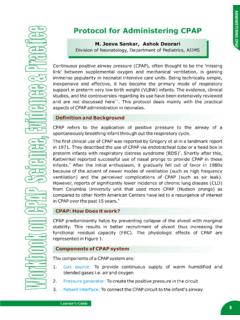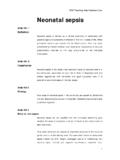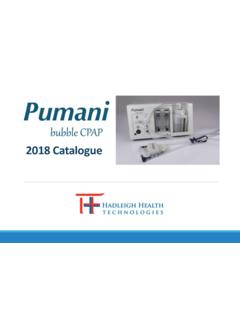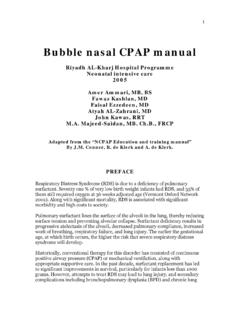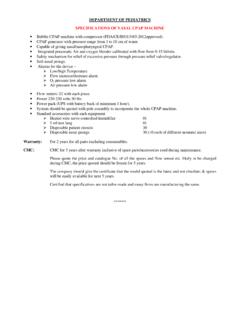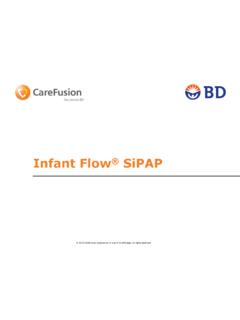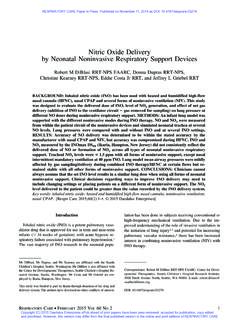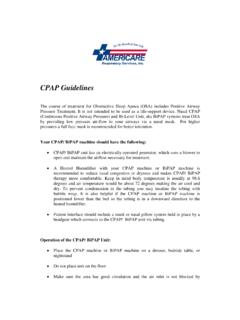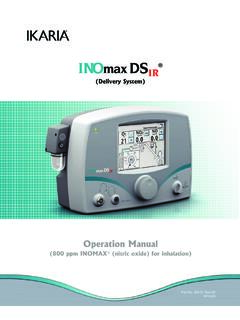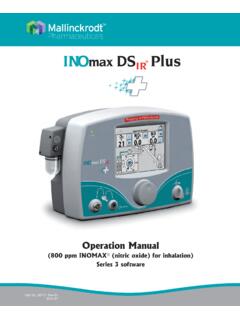Transcription of Protocol for Administering Continuous Positive Airway ...
1 AIIMS- NICU protocols 2008 Protocol for Administering Continuous Positive Airway pressure in Neonates M. Jeeva Sankar, Jhuma Sankar, Ramesh Agarwal, Vinod Paul, Ashok DeorariDivision of Neonatology, Department of PediatricsAll India Institute of Medical SciencesAnsari Nagar, New Delhi 110029 Address for correspondence:Prof Ashok DeorariProfessorDepartment of PediatricsAll India Institute of Medical SciencesAnsari Nagar, New Delhi 110029 Email: Downloaded from AIIMS- NICU protocols 2008 Downloaded from AIIMS- NICU protocols 2008 AbstractContinuous Positive Airway pressure ( cpap ) is a simple, inexpensive and gentle mode of respiratory support in preterm very low birth weight (VLBW) infants.
2 It helps by preventing the alveolar collapse and increasing the functional residual capacity of the lungs. Since it results in less ventilator induced lung injury than mechanical ventilation, it should theoretically reduce the incidence of chronic lung disease in VLBW infants. Various devices have been used for cpap generation and delivery. The relative merits and demerits of these devices and the guidelines for cpap therapy in neonates are discussed in this Protocol . Key words: Continuous Positive Airway pressure , Devices, Fixation, Treatment, Protocol Downloaded from AIIMS- NICU protocols 2008 INTRODUCTIONC ontinuous Positive Airway pressure ( cpap ), often thought to be the missing link between supplemental oxygen and mechanical ventilation, is gaining immense popularity in neonatal intensive care units.
3 Being technically simple, inexpensive and effective, it has become the primary mode of respiratory support in preterm very low birth weight (VLBW) infants. The evidence, clinical studies, and the controversies regarding its use have been extensively reviewed and are not discussed here. 1, 2 This Protocol deals mainly with the practical aspects of cpap administration in neonates. DEFINITION AND BACKGROUNDCPAP refers to the application of Positive pressure to the Airway of a spontaneously breathing infant through out the respiratory first clinical use of cpap was reported by Gregory et al in a landmark report in 1971. They described the use of cpap via endotracheal tube or a head box in preterm infants with respiratory distress syndrome (RDS).3 Shortly after this, Kattwinkel reported successful use of nasal prongs to provide cpap in these After the initial enthusiasm, it gradually fell out of favor in 1980s because of the advent of newer modes of ventilation (such as high frequency ventilation) and the perceived complications of cpap (such as air leak).
4 However, reports of significantly lower incidence of chronic lung disease (CLD) from Columbia University unit that used more cpap (Hudson prongs) as compared to other North American Centers have led to a resurgence of interest in cpap over the past 15 years. 5 cpap : HOW DOES IT WORK? cpap predominantly helps by preventing collapse of the alveoli with marginal stability. This results in better recruitment of alveoli thus increasing the functional residual capacity (FRC). The physiologic effects of cpap are represented in Figure OF cpap SYSTEMThe components of a cpap system are: Downloaded from AIIMS- NICU protocols source: To provide Continuous supply of warm humidified and blended gases air and oxygen generator: To create the Positive pressure in the interface/delivery system: To connect the cpap circuit to the infant s Airway .
5 Figure 1: Effects of CPAPF igure1: Effects of cpap (FRC, functional residual capacity; V/Q, ventilation-perfusion ratio; PVR, pulmonary vascular resistance; PaCO2 & PaO2, partial pressure of carbon-di-oxide and oxygen respectively in the arterial blood)Devices used for pressure generation Downloaded from collapse of alveoli with marginal stabilitySplints open Upper airwayStabilizes the chest wallReduces Airway resistanceReduces work of breathingRecruitment of more alveoliMaintains lung at FRCI ncreased alveolar surface area for gas exchangePaCO2 PaO2 Improves V/Q mismatch and Reduces intrapulmonary shuntConservation of endogenous surfactant Reduces obstructive apneaImproves pH PaO2 Reduces PVRS tretches lung and pleura upper airwayStimulates stretch receptorsReduces mixed and central apnea AIIMS- NICU protocols 2008 The pressure sources of cpap can be broadly grouped into: flow flow devices (Figure2) bubble cpap : A typical bubble cpap setup is shown in Panel 2.
6 One has to remember that though classified as a Continuous flow device, flow may still need to be adjusted to maintain Continuous bubbling in the water chamber and thus the required level of cpap . Variable flow cpap : A typical example is the Infant flow driver (IFD). It uses the Bernoulli Effect via dual injector jets directed towards each nasal prong to maintain a constant pressure . If the infant requires more inspiratory flow, the Venturi action of the injector jets entrains additional flow. When the infant makes a spontaneous expiratory effort, there is a fluidic flip that causes the flow to flip around and to leave the generator chamber via the expiratory limb (Coanda effect). So, unlike in the other methods of cpap where the infant has to exhale against the incoming gas flow, the fluidic flip of the variable flow devices assist his exhalation thus reducing the work of breathing. Figure2: Types of cpap devices Downloaded from flow devicesVary the cpap pressure by a mechanism other than flow variationVariable flow devicesThe desired cpap level is generated by varying the ventilator/Stand-alone cpap machines: pressure is generated by the exhalation valve and adjusted by varying the expiratory orifice cpap : pressure is generated by submerging the Common examples: flow driver (IFD) SiPAP cpap pressure is generated at the Airway proximal to the infant s nares.
7 cpap pressure generators AIIMS- NICU protocols 2008We use Continuous flow cpap by both conventional ventilators and bubble cpap device in our unit. The advantages and disadvantages of each of these methods are given in Table 1: A comparison of cpap devices used for pressure generation7 DeviceExamplesApproximate Cost (INR)Advantages DisadvantagesRemarks Conventional ventilator derived CPAPBear Cub, Bird-VIP, Draeger Baby log, Newport, Sechrist, Siemens, SLE, etc. 5 10 lakhs No need of a separate equipment Can be easily switched over to mechanical ventilation, if cpap fails Expensive Standard flow of 5-8L/min may be insufficient in the presence of high leak Difficult to know if the set flow is sufficient or not (insufficient flow can lead to increased WOB)Of practical utility in units having ventilators but not so in a small hospital/nursing home without a neonatal ventilator.
8 Stand-alone cpap machines ( Indigenous cpap )Lectromedik, Meditrin, Phoenix, Shreeyash, Zeal25,000 to 80,000 Economical Useful for small hospitals Can have bubble cpap option Most of them do not have proper blenders and/or pressure manometerThough inexpensive, they have not been tested adequately; niggling issues observed during daily useBubble CPAPI ndian:Mediserve,MeditrinImported:Fisher & Paykel50,000 to 80,0001,60,000 Simple and inexpensive Oscillations produced by Continuous bubbling might contribute to gas exchange (akin to HFV) Can identify large leaks at the nares (bubbling stops) Flow has to be altered to ensure proper bubbling It is difficult to detect high flow which can lead to over distension of the lungsIt seems unlikely that oscillations delivered at the nares are transmitted up to the alveoli; Still, the stand-alone option makes it an easy and cost effective proposition in developing countries Variable flow devicesArabella, IFD, Viasys SiPAP 3 lakhs Maintains more uniform pressure Might decrease the WOB Recruits lung volume more effectively Expensive Requires more technical expertiseOn theoretical grounds, this device scores more than the other two; However the prohibitive cost and the lack of evidence regarding its superiority preclude its widespread use(WOB, work of breathing; HFV, high frequency ventilation; IFD, infant flow driver) Downloaded from AIIMS- NICU protocols 2008 Devices used for cpap delivery (Patient interface)Various devices used for cpap delivery prongs (single/double or binasal) (or) nasopharyngeal prongs masks (Figure 3).
9 Face mask, endotracheal, and head box are no longer used for cpap delivery in neonates. Endotracheal cpap is not recommended because it has been found to increase the work of breathing (infant has to breathe through a straw ). The advantages and disadvantages of each of these methods have been summarized in Table 2. Figure 3: cpap delivery systemsTable 2: Advantages and disadvantages of common cpap delivery systemsDelivery system Advantages DisadvantagesRemarksNasal prongs (single/binasal)Example: Argyle Hudson IFD prongs Simple device Lower resistance leads to greater transmission of pressure Mouth leak acts like a pop-off mechanism Relatively difficult to fix Risk of trauma to nasal septum and turbinates Leak through mouth means end expiration pressure is variableStudies have shown that they are more effective than nasopharyngeal prongs (in post-extubation setting)8 Nasopharyngeal prongs ( using a cut endotracheal tube) Easy availability Economical More secure fixation More easily blocked by secretions Likely to get kinkedThough more economical and easily available, they are found to be inferior to Downloaded from Commonly used AIIMS- NICU protocols 2008 Length is estimated by measuring the distance from the earlobe to the tip of the chin or nose.
10 Tube placement is confirmed by direct visualization of the tip behind the uvulashort binasal prongs8 Nasal cannulae (with an outer diameter of 3mm and flows up to 2 L/min)Ease of application Unreliable pressure delivery May need high flows to generate pressureif only oxygen is used (without air blender) FiO2 delivered may be high Large leaks around the cannulae Mainly tried in apnea of prematurity paucity of data in other conditions 9 Still experimentalNasal masksMinimal nasal traumaDifficulty in obtaining an adequate sealNew generation masks are yet to be studied in detail(IFD, infant flow driver)In our unit, we use short bi-nasal prongs for delivering cpap (both ventilator and bubble cpap ).INDICATIONS FOR CPAPThe common clinical indications of cpap have been listed in Panel 1. Panel 1: Indications for CPAPP ractically, cpap is very useful in preterm (<35 weeks ) infants with respiratory distress/failure of any etiology. Some of these indications have been briefly described below: Downloaded from distress syndrome (RDS) of prematurity (especially obstructive apnea) in preterm VLBW tachypnea of newborn (TTNB)/delayed adaptationOther aspiration/ other aspiration edema/pulmonary tracheomalacia/ bronchomalacia AIIMS- NICU protocols : The most common indication for cpap is mild to moderate RDS.
